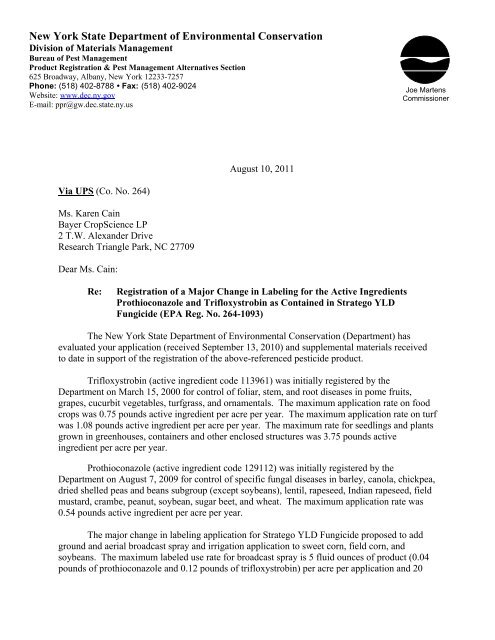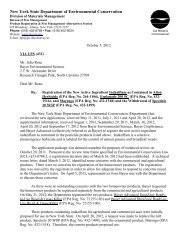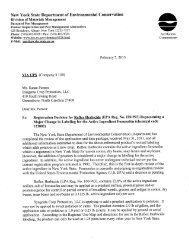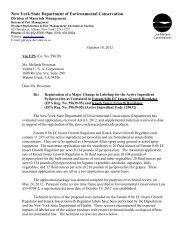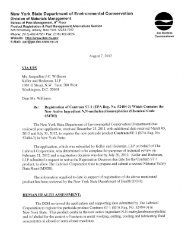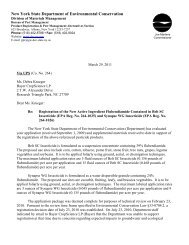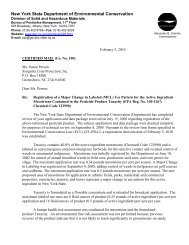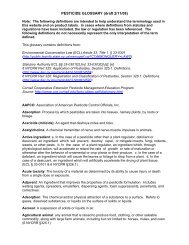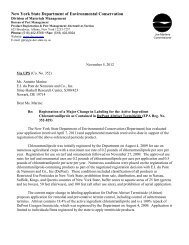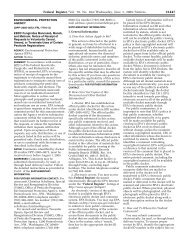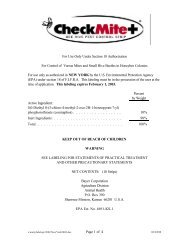Prothioconazole/Trifloxystrobin
Prothioconazole/Trifloxystrobin
Prothioconazole/Trifloxystrobin
You also want an ePaper? Increase the reach of your titles
YUMPU automatically turns print PDFs into web optimized ePapers that Google loves.
New York State Department of Environmental Conservation<br />
Division of Materials Management<br />
Bureau of Pest Management<br />
Product Registration & Pest Management Alternatives Section<br />
625 Broadway, Albany, New York 12233-7257<br />
Phone: (518) 402-8788 • Fax: (518) 402-9024<br />
Website: www.dec.ny.gov<br />
E-mail: ppr@gw.dec.state.ny.us<br />
Via UPS (Co. No. 264)<br />
Ms. Karen Cain<br />
Bayer CropScience LP<br />
2 T.W. Alexander Drive<br />
Research Triangle Park, NC 27709<br />
Dear Ms. Cain:<br />
August 10, 2011<br />
Re: Registration of a Major Change in Labeling for the Active Ingredients<br />
<strong>Prothioconazole</strong> and <strong>Trifloxystrobin</strong> as Contained in Stratego YLD<br />
Fungicide (EPA Reg. No. 264-1093)<br />
Joe Martens<br />
Commissioner<br />
The New York State Department of Environmental Conservation (Department) has<br />
evaluated your application (received September 13, 2010) and supplemental materials received<br />
to date in support of the registration of the above-referenced pesticide product.<br />
<strong>Trifloxystrobin</strong> (active ingredient code 113961) was initially registered by the<br />
Department on March 15, 2000 for control of foliar, stem, and root diseases in pome fruits,<br />
grapes, cucurbit vegetables, turfgrass, and ornamentals. The maximum application rate on food<br />
crops was 0.75 pounds active ingredient per acre per year. The maximum application rate on turf<br />
was 1.08 pounds active ingredient per acre per year. The maximum rate for seedlings and plants<br />
grown in greenhouses, containers and other enclosed structures was 3.75 pounds active<br />
ingredient per acre per year.<br />
<strong>Prothioconazole</strong> (active ingredient code 129112) was initially registered by the<br />
Department on August 7, 2009 for control of specific fungal diseases in barley, canola, chickpea,<br />
dried shelled peas and beans subgroup (except soybeans), lentil, rapeseed, Indian rapeseed, field<br />
mustard, crambe, peanut, soybean, sugar beet, and wheat. The maximum application rate was<br />
0.54 pounds active ingredient per acre per year.<br />
The major change in labeling application for Stratego YLD Fungicide proposed to add<br />
ground and aerial broadcast spray and irrigation application to sweet corn, field corn, and<br />
soybeans. The maximum labeled use rate for broadcast spray is 5 fluid ounces of product (0.04<br />
pounds of prothioconazole and 0.12 pounds of trifloxystrobin) per acre per application and 20
Ms. Karen Cain 2.<br />
fluid ounces of product (0.16 pounds of prothioconazole and 0.48 pounds of trifloxystrobin) per<br />
acre per year. Near the end of the technical review process, Bayer CropScience LP (Bayer)<br />
petitioned to add barley and wheat to the list of proposed crops. These crops were previously<br />
approved for prothioconazole but not trifloxystrobin. The proposed use rates for wheat and<br />
barley are less than or equal to the corn and soybean rates. In addition, corn and soybean acreage<br />
in New York State is several times higher than the acreage of wheat and barley in the State.<br />
Therefore, no additional review parameters were required for the wheat and barley use.<br />
The application package was deemed complete for purposes of technical review on<br />
January 27, 2011. Pursuant to the review time frame specified in Environmental Conservation<br />
Law §33-0704.2, a registration decision date of June 24, 2011 was established. Technical<br />
reviews of the proposed uses included on the Stratego YLD label have been performed by the<br />
Department and the New York State Department of Health. On June 2, 2011, the Department<br />
sent a “Technical Issues” letter to Bayer describing concerns with respect to the aerial<br />
application and chemigation methods of application described on the Stratego label. Bayer’s<br />
response was received by the Department on July 12, 2011. The Department has determined that<br />
Bayer’s response sufficiently mitigates the Department’s concerns. The technical reviews are<br />
shown below.<br />
HUMAN HEALTH ASSESSMENT:<br />
The following assessment was prepared by staff within the Bureau of Toxic Substance<br />
Assessment at the New York State Department of Health.<br />
On an acute basis, the formulated product Stratego YLD Fungicide was not very toxic<br />
via the oral, dermal and inhalation routes of exposure. This pesticide product did not cause skin<br />
or eye irritation (tested on rabbits) or skin sensitization (tested on guinea pigs).<br />
<strong>Trifloxystrobin</strong><br />
We have previously reviewed the active ingredient trifloxystrobin for the pesticide<br />
products Flint Fungicide and Compass Fungicide. The available information on trifloxystrobin<br />
indicated that it is not very toxic or irritating following acute exposures in laboratory animals,<br />
but is a strong skin sensitizer. Data from chronic and developmental/reproductive toxicity<br />
studies showed that trifloxystrobin has the potential to cause some toxicity, principally liver<br />
effects. The U.S. Environmental Protection Agency (U.S. EPA) classified this chemical as “not<br />
likely to be carcinogenic to humans” based on a lack of evidence of carcinogenicity in rat and<br />
mouse chronic feeding studies. The U.S. EPA Office of Pesticide Programs (OPP) established<br />
an acute oral reference dose (aRfD) for females 13–49 years of age of 2.5 milligrams per<br />
kilogram body weight per day (mg/kg/day) based on a no-observed-effect level (NOEL) of 250<br />
mg/kg/day from a developmental toxicity study in rats (increased fetal skeletal anomalies) and an<br />
uncertainty factor of 100. The U.S. EPA OPP additionally established a chronic oral reference<br />
dose (cRfD) for trifloxystrobin of 0.038 mg/kg/day based on a NOEL of 3.8 mg/kg/day from a<br />
two-generation reproductive toxicity study in rats (decreased body weight, body weight gain and<br />
food consumption; liver, kidney and spleen effects) and an uncertainty factor of 100. A current
Ms. Karen Cain 3.<br />
search of the toxicological literature did not find any significant new information on the toxicity<br />
of trifloxystrobin.<br />
The U.S. EPA established tolerances for trifloxystrobin residues in or on field corn,<br />
sweet corn and popcorn which ranged from 0.05 parts per million (ppm) to 7 ppm depending on<br />
the corn commodity (Federal Register Vol. 67:35,915–35,924, May 22, 2002; Vol. 71:15,597–<br />
15,604, March 29, 2006; and Vol. 75:33,190–33,195, June 11, 2010) and in or on soybeans of 10<br />
ppm (forage), 25 ppm (hay) and 0.08 ppm (seed). The U.S. EPA established an acute<br />
population adjusted dose (aPAD) of 2.5 mg/kg/day for females 13–49 years of age that has the<br />
same basis as the aRfD. The U.S. EPA estimated that the acute dietary exposure to<br />
trifloxystrobin residues from all crops for which there are tolerances, and from drinking water,<br />
would be less than one percent of the aPAD for this subgroup. The chronic population adjusted<br />
dose (cPAD) for trifloxystrobin for the general public and all population subgroups is 0.038<br />
mg/kg/day and has the same basis as the cRfD. The U.S. EPA estimated that the chronic dietary<br />
exposure to trifloxystrobin residues in food and drinking water from all registered uses would be<br />
15 percent of the cPAD for the general population, 34 percent for all infants and 43 percent for<br />
children 1–2 years of age, the most highly exposed subgroup. These exposure analyses are based<br />
on the conservative assumptions that 100 percent of the crops are treated and that these treated<br />
crops contain tolerance level residues.<br />
The U.S. EPA conducted an occupational risk assessment for short- (1–30 days) and<br />
intermediate-term (1–6 months) dermal and inhalation exposures to trifloxystrobin. Exposure<br />
estimates were created for scenarios involving aerial and groundboom application methods to<br />
soybeans or corn. For determining margins of exposure (MOEs), the U.S. EPA compared<br />
estimated short- and intermediate-term dermal exposures to a NOEL of 100 mg/kg/day from a<br />
28-day dermal toxicity study in rats (increased liver and kidney weights). Short- and<br />
intermediate-term inhalation exposures were compared to a NOEL of 3.8 mg/kg/day from a twogeneration<br />
reproductive toxicity study in rats (decreased body weight, body weight gain and food<br />
consumption; liver, kidney and spleen effects). Estimated short- and intermediate-term dermal<br />
MOEs were 2,100 for mixers/loaders, 20,000 for groundboom applicators, 9,600 for aerial<br />
applicators and 14,000 for flaggers (supporting aerial applications). The estimated MOEs for<br />
short- and intermediate-term inhalation exposures to trifloxystrobin were 1,500 for<br />
mixers/loaders, 15,000 for groundboom applicators, 27,000 for aerial applicators and 18,000 for<br />
flaggers. These estimates assumed that workers wore long-sleeved shirt and long pants, shoes<br />
plus socks and chemical resistant gloves, except for aerial applicators who are assumed not to<br />
wear gloves because of lowered expected exposures from engineering controls (enclosed<br />
cockpit). The U.S. EPA conducted a screening level assessment of dermal risks to workers 12hours<br />
post-application; the estimated MOE for detasseling of corn grown for seed, the highest<br />
potential contact activity, was 190. The U.S. EPA considered MOEs of 100-fold or greater for<br />
dermal and inhalation exposures to provide adequate worker protection for trifloxystrobin.<br />
<strong>Prothioconazole</strong><br />
In the past, the New York State Department of Health reviewed the toxicological<br />
properties of the active ingredient prothioconazole (and prothioconazole-desthio, its primary<br />
metabolite/degradate) in the pesticide product Proline 480 SC Fungicide. <strong>Prothioconazole</strong> and
Ms. Karen Cain 4.<br />
prothioconazole-desthio were not very acutely toxic, irritating to the eyes or skin, nor sensitizers.<br />
Data from chronic and developmental/reproductive animal studies indicate that both<br />
prothioconazole and prothioconazole-desthio have the potential to cause toxicity, with<br />
prothioconazole-desthio generally being more toxic than prothioconazole. However, neither<br />
prothioconazole nor prothioconazole-desthio (unlike many other fungicides in the triazole<br />
chemical class) demonstrated carcinogenic potential in laboratory animals. The U.S. EPA<br />
classified prothioconazole as “not likely to be carcinogenic to humans” based on the absence of<br />
significant tumor increases in two adequate rodent carcinogenicity studies. The U.S. EPA OPP<br />
established an aRfD for females 13–49 years of age of 0.02 mg/kg/day based on a NOEL of 2.0<br />
mg/kg/day from a developmental toxicity study in rabbits with prothioconazole-desthio<br />
(structural alterations and multiple malformations) and an uncertainty factor of 100. The U.S.<br />
EPA OPP additionally established a cRfD for prothioconazole of 0.01 mg/kg/day based on a<br />
NOEL of 1.1 mg/kg/day from a chronic toxicity/oncogenicity study in rats (liver histopathology)<br />
and an uncertainty factor of 100. A current search of the toxicological literature did not find any<br />
significant new information on the toxicity of prothioconazole.<br />
The U.S. EPA established tolerances for prothioconazole residues in or on sweet corn<br />
(kernel plus cob with husks removed) of 0.04 ppm and soybeans of 4.5 ppm (forage), 17 ppm<br />
(hay) and 0.15 ppm (seed). The U.S. EPA established an aPAD of 0.02 mg/kg/day for females<br />
13–49 years of age that has the same basis as the aRfD. The U.S. EPA estimated that the acute<br />
dietary exposure to prothioconazole residues from all crops for which there are tolerances, and<br />
from drinking water, would be 38 percent of the aPAD for this subgroup. The cPAD for<br />
prothioconazole established by the U.S. EPA for the general public and all population subgroups<br />
is 0.01 mg/kg/day and has the same basis as the cRfD. The U.S. EPA estimated that the chronic<br />
dietary exposure to prothioconazole residues in food and drinking water from all registered uses<br />
would be 21 percent of the cPAD for the general population, 35 percent for children 1–2 years of<br />
age and 62 percent for all infants (less than one year of age), the most highly exposed subgroup.<br />
These exposure analyses are based on the conservative assumptions that 100 percent of the crops<br />
are treated and that these treated crops contain tolerance level residues.<br />
The U.S. EPA conducted an occupational risk assessment for short- (1–30 days) and<br />
intermediate-term (1–6 months) dermal and inhalation exposures to prothioconazole and/or<br />
prothioconazole-desthio. Exposure estimates were created for scenarios involving aerial,<br />
chemigation and groundboom application methods to soybeans or corn. For determining MOEs,<br />
the U.S. EPA compared estimated short- and intermediate-term dermal exposures to a NOEL of<br />
30 mg/kg/day from a dermal developmental toxicity study in rats with prothioconazole-desthio<br />
(increased incidence of supernumerary rib). Short- and intermediate-term inhalation exposures<br />
were compared to a NOEL of 2 mg/kg/day from a developmental toxicity study in rabbits with<br />
prothioconazole-desthio (structural alterations and multiple malformations). Estimated short-<br />
and intermediate-term combined dermal and inhalation MOEs for mixers/loaders were 4,000<br />
supporting chemigation or aerial applications and 5,700 supporting groundboom applications to<br />
soybeans. The estimated MOEs for applicators of prothioconazole to soybeans were 11,000 for<br />
groundboom applications and 6,600 for aerial applications. In addition, the MOE for flaggers<br />
supporting aerial applications was 8,200. The estimated MOEs for short- and intermediate-term<br />
combined dermal and inhalation exposures to prothioconazole from application to corn were<br />
3,800 and 5,300 for mixers/loaders, 10,000 for groundboom applicators, 6,000 for aerial
Ms. Karen Cain 5.<br />
applicators and 7,500 for flaggers. These estimates assumed that workers wore long-sleeved<br />
shirt and long pants, shoes plus socks and mixer/loaders additionally wore chemical resistant<br />
gloves. The U.S. EPA considered MOEs of 100-fold or greater for dermal and inhalation<br />
exposures to provide adequate worker protection for prothioconazole and prothioconazoledesthio.<br />
The U.S. EPA additionally conducted an occupational risk assessment for day zero postapplication<br />
dermal exposures to prothioconazole for several activities to soybean, corn and sweet<br />
corn. For determining MOEs, the U.S. EPA compared short- and intermediate-term dermal<br />
exposures to a NOEL of 30 mg/kg/day from the dermal developmental toxicity study in rats with<br />
prothioconazole-desthio. The estimated dermal MOEs for hand weeding/scouting and<br />
irrigation/scouting soybeans were 11,000 and 740, respectively. For the post-application<br />
activities to corn of scouting/weeding, irrigation/scouting and detasseling, the estimated dermal<br />
MOEs were 4,200, 420 and 590, respectively. The estimated MOEs for sweet corn were 110 for<br />
hand harvesting, 18,000 for scouting/weeding and 1,800 for irrigation/scouting. For this risk<br />
assessment, dermal MOEs of 100-fold or greater were considered by the U.S. EPA to provide<br />
adequate protection for post-application worker exposures to prothioconazole and<br />
prothioconazole-desthio.<br />
There are no chemical specific federal or New York State drinking water/groundwater<br />
standards for trifloxystrobin or prothioconazole (or their degradates). Based on their chemical<br />
structures, these chemicals each fall under the 50 microgram per liter (μg/L) New York State<br />
drinking water standard for “unspecified organic contaminants” (10 NYCRR Part 5, Public<br />
Water Systems). The New York State drinking water standard for the sum of “unspecified<br />
organic contaminants” and “principal organic contaminants” is 100 µg/L.<br />
Summary<br />
The available information on trifloxystrobin, prothioconazole and Stratego YLD<br />
Fungicide indicates that they are not very acutely toxic in laboratory animal studies. Both<br />
trifloxystrobin and prothioconazole were classified by the U.S. EPA as “not likely to be<br />
carcinogenic to humans.” Although data from subchronic, chronic and<br />
developmental/reproductive studies showed that these two chemicals have the potential to cause<br />
some toxicity, especially liver toxicity, trifloxystrobin and prothioconazole have different modes<br />
of action and the effects are not expected to be cumulative. Dietary exposure of the general<br />
public to trifloxystrobin and prothioconazole residues on currently labeled crops is not expected<br />
to pose significant health risks. Also, the estimated risks to workers from use of Stratego YLD<br />
Fungicide are within the range that is generally considered acceptable.<br />
Given the above, we do not object to expanding the uses of trifloxystrobin and<br />
prothioconazole in the state on sweet corn, field corn and soybeans on the basis of direct health<br />
risks from dietary and worker exposure.
Ms. Karen Cain 6.<br />
ENVIRONMENTAL FATE ASSESSMENT:<br />
The following assessment was prepared by Engineering Geology staff within the Bureau<br />
of Pest Management.<br />
Technical Review of <strong>Trifloxystrobin</strong><br />
No environmental fate information was submitted for this active ingredient, so this review was<br />
taken from the November 12, 1999 technical review of trifloxystrobin done for Flint and<br />
Compass.<br />
Solubility: <strong>Trifloxystrobin</strong> has a solubility of 0.61 ppm.<br />
.<br />
Hydrolysis: <strong>Trifloxystrobin</strong> was stable in pH 5, has a half-life of 55.2 days at pH 7, and<br />
19.8 hours at pH 9.<br />
Aqueous Photolysis: <strong>Trifloxystrobin</strong> had a half-life of 14.8 days; however EPA had<br />
problems with this study.<br />
Soil Photolysis: Degradation was too rapid to determine a half-life.<br />
Aerobic Soil Metabolism: The half-life was biphasic with an apparent half-life of 0.72 days.<br />
The registrant calculated half-life was 2.0-2.4 days. Degradate CGA 321113 was found at 85.2%<br />
at 7 days in one study, at 93.2% at day 14 in a second study, and at 84.7% at 28 days and 39.5%<br />
at one year in a third study. CGA-357276 was found at 4.9% at 270 days, CGA-373466 and<br />
CGA-357262 were each found at < 4.1% from days 90 to 365 in the second study. CGA-<br />
373466, CGA-357261, CGA-331409 and CGA-320299 were each found at 1% throughout the<br />
third study.<br />
Aerobic Aquatic Metabolism: EPA was not satisfied with this study, but did state that the<br />
study indicated that trifloxystrobin degraded rapidly in aquatic aerobic environments.<br />
Anaerobic Aquatic Metabolism: The half-life was 0.72 days<br />
Aged Leaching: EPA did not accept this study, but did indicate that degradate CGA-321113 was<br />
very mobile in loamy sand, sandy loam and silt loam as well as mobile in loam and clay loam.<br />
CGA-356276 was present in quantities too low to assess mobility.<br />
Adsorption-Desorption Parent:<br />
Soil Type Adsorption Koc Desorption Koc<br />
Loamy sand 2354 3294<br />
Sandy loam 951 1387<br />
Low OM sand 3064 3528<br />
High OM sand 3927 2202<br />
Clay loam 9871 2504<br />
Silt loam 951 1203
Ms. Karen Cain 7.<br />
Adsorption-Desorption for CGA-321113:<br />
Soil Type Adsorption Koc Desorption Koc<br />
Loam 127 194<br />
Sandy soil 235 335<br />
Clay loam soil 130 188<br />
Sandy loam 48 70<br />
Sandy loam 80 109<br />
Adsorption-Desorption for CGA-357276:<br />
Soil Type Adsorption Koc Desorption Koc<br />
Sandy loam 8345 15169<br />
Loam 6587 8386<br />
Sandy loam 9228 11206<br />
Sand soil 9756 13575<br />
Clay soil 6934 8434<br />
Adsorption-Desorption for CGA-357261:<br />
Soil Type Adsorption Koc Desorption Koc<br />
Loam 476 587<br />
Clay loam 526 813<br />
Sandy loam 479 996<br />
Sandy loam 389 645<br />
Sand 567 864<br />
Adsorption-Desorption for CGA-373466:<br />
Soil Type Adsorption Koc Desorption Koc<br />
Sandy loam 31 39<br />
Loam 98 142<br />
Sandy loam 63 82<br />
Sand 166 220<br />
Clay loam 81 130<br />
Terrestrial Field Dissipation: Three field dissipation studies were performed, but the EPA did<br />
not accept any of them. The first study indicated that dissipation was biphasic with an initial<br />
half-life of 15.6 days and a second half-life of 182 days in a loamy sand. The parent was found<br />
at 158.2 ppb at day 14, dropping to 11.2 ppb at day 364, CGA-321113 was found at 156.1 ppb at<br />
day 78, dropping to 16.8 ppb at 364 days. It was found at the 6-12 inch depth at 32.2 ppb on day<br />
91, dropping to 12.4 ppb at 364 days in the 12-18 inch depth at 19.9 ppb at day 124, dropping to<br />
126 ppb at day 364. CGA-357262 was found in the 0-6 inch depth at a maximum of 15.8 ppb on<br />
day 7, dropping to 10.3 ppb on day 364. CGA-357261 was found in the 6-12 inch depth at 13.2<br />
ppb on day 7. CGA-373466 was found in the 0-6 inch depth at 11.6 ppb at day 92. CGA<br />
331409 was found in the 0-6 inch depth at 10.8 ppb on day 7.
Ms. Karen Cain 8.<br />
The second study indicated an initial half-life of 1-3 days. The parent was found in the 0-6 inch<br />
depth at 80 ppb at 3 days, dropping to 10.2 ppb at 62 days. CGA-357261 was found in the 0-6<br />
inch depth at 31.4 ppb at day one, dropping to 10.5 ppb at day 13. CGA-321113 was found in<br />
the 0-6 inch depth at a maximum of 62.5 ppb at day one, dropping to 11.4 ppb on day 360.<br />
CGA-373466 was found in the 0-6 inch depth at 15.7 ppb at day 27.<br />
In the third study in a loamy sand, the parent was found at the 0-6 inch depth at a maximum of<br />
93 ppb. CGA-321113 was found in the 6-12 inch depth once at 11 ppb; CGA-474366 was found<br />
in the 0-6 inch depth at a maximum of 24 ppb; CGA-257261 was found once in the 0-6 inch<br />
depth at 18 ppb, and once in the 12-18 inch depth at 19 ppb; CGA-357262 was found once in the<br />
12-18 inch depth at 23 ppb.<br />
Technical Review of <strong>Prothioconazole</strong><br />
PARENT<br />
Solubility: <strong>Prothioconazole</strong> has a solubility of 5 ppm at pH 4 and 300 ppm at pH 8.<br />
Hydrolysis: (MRID 46246505 acceptable) <strong>Prothioconazole</strong> was stable in pH 4 (>10 years), 7<br />
(>1 year), and 9 (>1 year) aqueous buffer solutions.<br />
Aqueous Photolysis: (MRID 46246507 supplemental) <strong>Prothioconazole</strong> had an environmental<br />
phototransformation half-life of 9.7 days with major transformation products JAU6476-desthio<br />
at 54.8% and JAU6476-thiazocine at 14.1% on the phenyl label, and JAU6476-desthio at 55.7%<br />
and 1,2,4-triazole at 11.9% in the triazole label.<br />
Soil Photolysis: (MRID 46246510 acceptable) <strong>Prothioconazole</strong> data indicated the same half-life<br />
for the irradiated samples as the dark samples, therefore phototransformation on soil does not<br />
appear to be a route of degradation. Major transformation product JAU6476-desthio was found<br />
in the irradiated sample at 38%.<br />
Aerobic Soil Metabolism:<br />
Soil<br />
Silt 1<br />
Loamy sand 1<br />
Sandy loam 2<br />
pH % OC Observed T 2<br />
Transformation products<br />
7.1 2.14 0-1 days JAU6476-desthio 49.4%<br />
JAU6476-S-methyl 12.8%<br />
6.8 0.79 0-3 days JAU6476-desthio 41.2%<br />
JAU6476-S-methyl 14.6%<br />
7.2 2.0 0-1 days JAU6476-desthio 42.3%<br />
Silty clay loam 2<br />
5.9 1.66 0-1 days JAU6476-desthio 20.9%<br />
1 2<br />
MRID 46246511 acceptable; MRID 46246512 acceptable.
Ms. Karen Cain 9.<br />
Aerobic Aquatic Soil Metabolism:<br />
Soil<br />
Water/loam 1<br />
Water/loamy<br />
sand 1<br />
Water/sandy<br />
clay loam 2<br />
pH<br />
Soil<br />
6.6<br />
8.5<br />
% OC<br />
Soil<br />
Observed T 2<br />
water/soil/system<br />
4.8 14.9 days water<br />
48.5 days system<br />
1.37 17.8 days water<br />
33.6 days system<br />
1-3 days water<br />
91-120 days system<br />
1 MRID 46246515 supplemental; 2 MRID 46246515 acceptable.<br />
Transformation products<br />
JAU6476-desthio 32.3<br />
JAU6476-desthio 21.9<br />
1,2,4-triazole 37.2<br />
JAU6476-S-methyl 26.9<br />
JAU6476-desthio 32.9<br />
JAU6476-S-methyl 77.0<br />
Aged Leaching: (MRID 46246539 supplemental) Sorption coefficients could not be<br />
determined due to instability of the compound in the systems.<br />
(MRID 46246504 acceptable) Kocs could not be calculated due to low column resolution.<br />
However, U.S. EPA went on to say that prothioconazole showed very little potential for leaching<br />
as very low total radioactive residues were detected in the leachate and very little unchanged<br />
parent compound was translocated below the aged soil layer. The studies also indicate that the<br />
parent has lower mobility than the degradates JAU6476-desthio, and JAU6476-S-methyl, and<br />
batch studies for these two transformation products indicate that they have low mobility.<br />
Terrestrial Field Dissipation: (MRID 46246517 supplemental) Field dissipation studies<br />
performed on a sandy loam-loam (pH 7.9, % OC 0.27) indicated an observed half-life of 7 days.<br />
Major transformation product JAU6476-desthio was found at 21.5%. Observed major<br />
transformation half-lives were JAU6476-desthio at 63 days and JAU6476-S-methyl at 14-29<br />
days.<br />
(MRID 46246518 supplemental) Field dissipation studies performed on a loamy sand-sandy<br />
loam (pH 6.2, % OC 1.1) indicated an observed half-life of
Ms. Karen Cain 10.<br />
(MRID 46246523 supplemental) <strong>Prothioconazole</strong> dissipated in paddy water with a calculated<br />
half-life of 4.8 days. The half-life in the sediment/soil could not be determined due to too few<br />
detections.<br />
(MRID 46246524 supplemental) <strong>Prothioconazole</strong> dissipated in paddy water with a calculated<br />
half-life of 0.6 days. The half-life in the sediment/soil could not be determined due to too few<br />
detections.<br />
TRANSFORMATION PRODUCTS:<br />
Solubility JAU6476-desthio: The solubility of JAU6476-desthio is 22 ppm.<br />
Hydrolysis JAU6476-desthio: (MRID 46246506 supplemental) JAU6476-desthio was stable at<br />
pH 5, 7, and 9.<br />
Aerobic Metabolism JAU6476-desthio: (MRID 46246513 supplemental). No major<br />
transformation products found.<br />
Soil<br />
Silt loam<br />
Silt loam<br />
Sandy loam<br />
Silty clay<br />
pH<br />
7.3<br />
7.9<br />
7.2<br />
6.3<br />
% OC<br />
T 2 JAU6476-desthio<br />
linear/nonlinear/empirical<br />
1.55 55.5/29.4/3-7 days<br />
0.98 45.3/29.0/14-30 days<br />
1.02 22.6/6.8/3-7 days<br />
1.46 30.3/18.6/7-14 days<br />
T 2 JAU6476-desthio<br />
and bound residues<br />
linear/nonlinear/empirical<br />
165.0/144.4/
Ms. Karen Cain 11.<br />
Aerobic Metabolism JAU6476-S-methyl: (MRID 46246514 supplemental).<br />
Soil<br />
Silt loam<br />
Silt loam<br />
Sandy loam<br />
pH<br />
7.3<br />
7.9<br />
7.2<br />
% OC T 2 JAU6476-S-methyl<br />
linear/nonlinear/empirical<br />
1.55 25.1/5.6/1-3 days<br />
0.98 47.5/26.1/14 days<br />
1.02 28.4/7.5/3 days<br />
T 2 JAU6476-S-methyl<br />
and bound residues<br />
linear/nonlinear/empirical<br />
86.6/74.5/7-14 days<br />
173.3/154/>125 days<br />
123.8/92.4/14 days<br />
Silty clay* 6.3 1.46 55.0/44.4/14-30 days 128.4/111.8/125 days<br />
*Major transformation products found only in silty clay were M2 at 10.0% and M6 24.7%.<br />
Adsorption/Desorption Transformation Product JAU6476-S-methyl: (MRID 462464501<br />
acceptable)<br />
Soil type<br />
Sandy loam<br />
Silt<br />
Silty clay loam<br />
Loamy sand<br />
pH %OC Adsorption Koc<br />
7.2 2.02 2772<br />
7.1 2.14 2995<br />
5.9 1.66 2484<br />
6.8 0.79 1973<br />
Desorption Koc<br />
3124<br />
3358<br />
2926<br />
2532<br />
Label statements: A<strong>Prothioconazole</strong>-desthio (a degradate of prothioconazole) is known to leach<br />
through soil into groundwater under certain conditions as a result of labeled use. Use of this<br />
chemical in areas where soils are permeable, particularly where the water table is shallow, may<br />
result in ground-water contamination.<br />
Drift and runoff are hazardous to aquatic organisms in water adjacent to treated areas. This<br />
product has a high potential for runoff for several months or more after application. Poorly<br />
draining soils and soils with shallow water tables are more prone to produce runoff that contains<br />
this product. A level, well maintained vegetative buffer strip between areas to which this<br />
product is applied and surface water features such as ponds, streams, and springs will reduce the<br />
potential for contamination of water from rainfall-runoff. Runoff of this product will be reduced<br />
by avoiding applications when rainfall is forecasted to occur within 48 hours.@<br />
Environmental Fate Summary: Given that the use rates for this product are less than those<br />
already allowed for use in NYS, and neither active ingredient was found to be a groundwater<br />
concern in past reviews, staff do not object to the use of this product on sweet corn, field corn<br />
and soybeans.
Ms. Karen Cain 12.<br />
ECOLOGICAL EFFECTS ASSESSMENT:<br />
The following assessment was produced by the Department’s Bureau of Habitat<br />
(BOH) within the Division of Fish, Wildlife, & Marine Resources:<br />
Both active ingredients in Stratego YLD Fungicide have been reviewed previously by<br />
BOH, trifloxystrobin most recently in May 2010 and prothioconazole in May 2009.<br />
USE PATTERN:<br />
Stratego YLD Fungicide is a broad spectrum fungicide for use on corn (sweet, pop, and<br />
field varieties) and soybeans. Applications of 4-5 fl oz. (4.65 fl oz. upper limit on soybeans) per<br />
acre (/A) are made using water as the carrier.<br />
On sweet corn sequential applications are not allowed. Each Stratego YLD application<br />
must be alternated with a fungicide with a different mode of action. No more than 20 fl oz. /A<br />
may be applied per season.<br />
On field corn and soybeans two sequential applications are allowed before rotating to a<br />
different mode of action. The retreatment interval is 7-14 days for field corn and 10-21 days for<br />
soybeans. No more than 10 fl oz./A may be applied to field corn per season. The seasonal limit<br />
for soybeans is 13.95 fl oz/A.<br />
The label allows aerial, ground, and chemigation applications.<br />
Application rates for both Stratego YLD active ingredients individually are lower than<br />
those reviewed previously. The total seasonal maximum Stratego YLD combined ai application<br />
rate is lower than previously reviewed trifloxystrobin rates. It is 0.1 lb ai/A higher than the<br />
maximum previous prothioconazole rate reviewed.<br />
EXPOSURE MODELING & RISK ASSESSMENT:<br />
Terrestrial- Standard BOH post application food-item residue exposure modeling for<br />
birds and mammals showed no potential for acute or chronic toxicity. These two groups are not<br />
discussed further.<br />
Aquatic- Application of Stratego YLD directly to the surface of a water body, the<br />
condition by which aerial application threat is evaluated, results in trifloxystrobin concentrations<br />
that far exceed lethal values. As described in previous trifloxystrobin reviews, trifloxystrobin is<br />
a rapidly lethal aquatic toxin. While its half-life in water is relatively short at 14.4 hours, the<br />
very high toxicity, rapid lethality, and resulting multiples of LC50s far outweigh its short resident<br />
time. Therefore, aerial applications of Stratego YLD pose an unacceptable risk to aquatic nontarget<br />
organisms.
Ms. Karen Cain 13.<br />
Runoff of the two active ingredients was modeled separately assuming the seasonal<br />
maximum rate of Stratego YLD had been applied. The resulting fish and invertebrate chronic<br />
toxicity is somewhat misleading. That toxicity is primarily a result of the trifloxystrobin content<br />
which degrades fairly rapidly in water. Exposures will not be of sufficient duration to result in<br />
chronic toxicity.<br />
One other issue requires attention. All previous prothioconazole labels, and the EPA<br />
<strong>Prothioconazole</strong> Pesticide Fact Sheet state that it may not be applied through any type of<br />
irrigation system. The Stratego YLD label allows chemigation applications. While not a<br />
significant fish or wildlife issue, it should be determined if this is a regulatory oversight. None<br />
of the materials submitted in support of registration of Stratego YLD give any explanation of this<br />
change. Based on the issues stated above with respect to aerial application and chemigation,<br />
Bureau of Habitat staff objected to the registration of the Stratego YLD as then labeled.<br />
In response to BOH concerns, Bayer has added a New York State aerial application<br />
prohibition to the label for Stratego YLD. The Bureau of Habitat has reviewed the revised<br />
labeling and other materials submitted and is satisfied with their content. The NY specific aerial<br />
application prohibition and the explanation of the chemigation label language resolve the only<br />
concerns BOH had with Statego YLD registration. Therefore, Bureau of Habitat staff does not<br />
object to registration of Stratego YLD in New York State.<br />
REGISTRATION DECISION<br />
Bayer CropScience LP has sufficiently mitigated the Department’s concerns expressed<br />
during the technical review of the Stratego product. Specifically, a New York State aerial<br />
application prohibition has been added to the Stratego YLD Fungicide label to protect aquatic<br />
species from a direct spray of trifloxystrobin to a water body. Therefore, the Department has<br />
registered Stratego YLD Fungicide (EPA Reg. No. 264-1093) for use in New York State.<br />
Enclosed for your record are copies of the Certificate of Pesticide Registration and stamped<br />
“Accepted for Registration” label.<br />
Please contact the Pesticide Product Registration Section, at (518) 402-8768, if you have<br />
any questions regarding this letter.<br />
Enclosures<br />
Sincerely,<br />
Scott Menrath<br />
Scott Menrath<br />
Director<br />
Bureau of Pest Management


